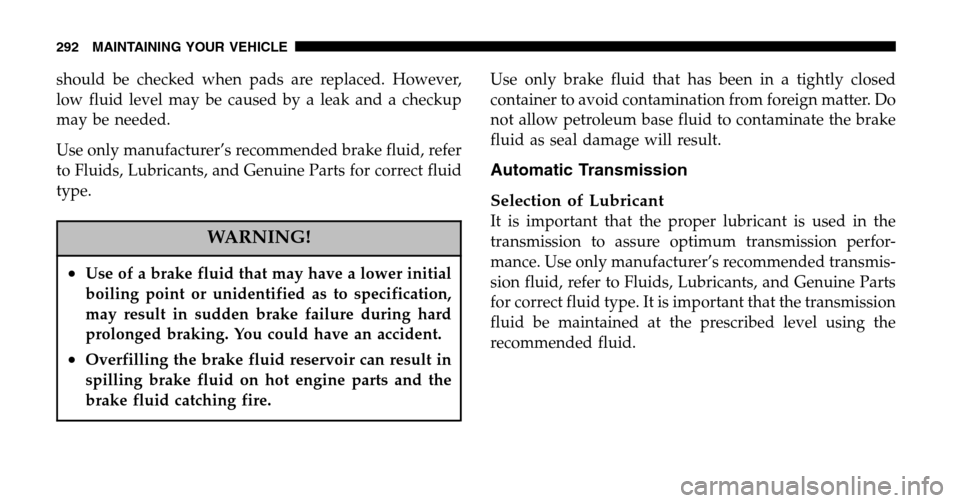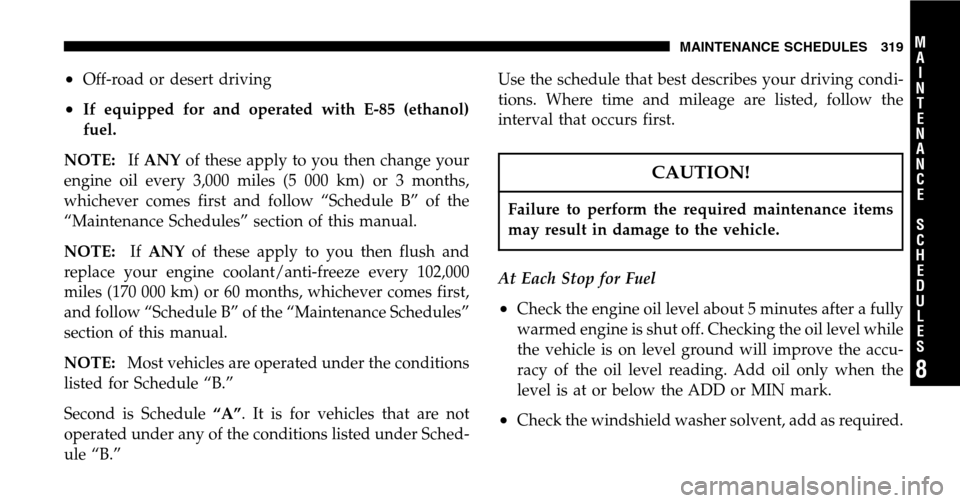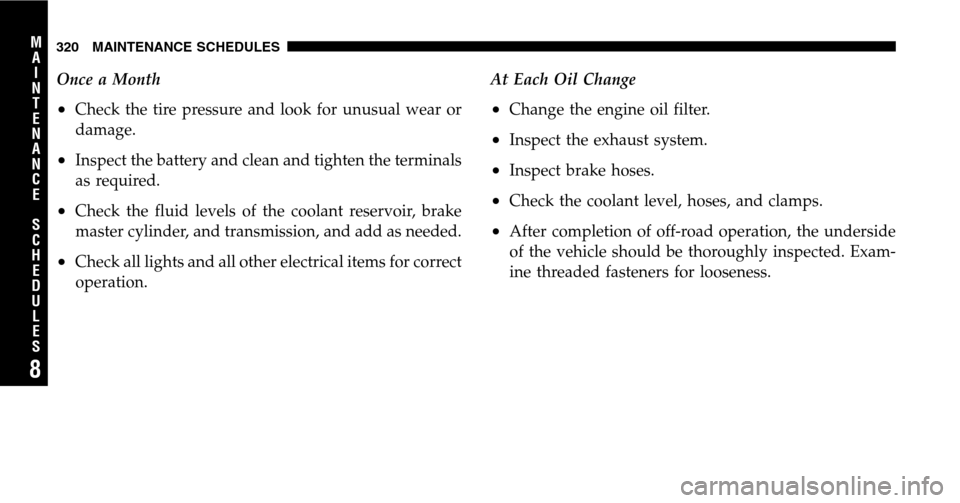check engine JEEP WRANGLER 2006 TJ / 2.G Owner's Manual
[x] Cancel search | Manufacturer: JEEP, Model Year: 2006, Model line: WRANGLER, Model: JEEP WRANGLER 2006 TJ / 2.GPages: 368, PDF Size: 14.3 MB
Page 288 of 368

children, do not store ethylene glycol based antifreeze/
coolant in open containers or allow it to remain in
puddles on the ground. If ingested by a child, contact a
physician immediately. Clean up any ground spills im-
mediately.
Engine Coolant Level
The coolant bottle provides a quick visual method for
determining that the coolant level is adequate. With the
engine idling, and warm to normal operating tempera-
ture, the level of the antifreeze/coolant in the bottle
should be between the ranges indicated on the bottle.
The radiator normally remains completely full, so there is
not need to remove the radiator cap unless checking for
antifreeze/coolant freeze point or replacing antifreeze/
coolant. Advise your service attendant of this. As long as
the engine operating temperature is satisfactory, the
coolant bottle need only be checked once a month. When additional antifreeze/coolant is needed to main-
tain the proper level, it should be added to the coolant
bottle. Do not overfill.
Points To Remember
NOTE:
When the vehicle is stopped after a few miles of
operation, you may observe vapor coming from the front
of the engine compartment. This is normally a result of
moisture from rain, snow, or high humidity accumulat-
ing on the radiator and being vaporized when the
thermostat opens, allowing hot antifreeze/coolant to
enter the radiator.
If an examination of your engine compartment shows no
evidence of radiator or hose leaks, the vehicle may be
safely driven. The vapor will soon dissipate.
•Do not overfill the coolant bottle.
288 MAINTAINING YOUR VEHICLE
Page 289 of 368

•Check antifreeze/coolant freeze point in the radiator
and in the coolant recovery bottle. If antifreeze/
coolant needs to be added, contents of coolant recov-
ery bottle must also be protected against freezing.
•If frequent antifreeze/coolant additions are required,
or if the level in the recovery bottle does not drop
when the engine cools, the cooling system should be
pressure tested for leaks.
•Maintain antifreeze/coolant concentration at 50%
HOAT antifreeze/coolant (minimum) and distilled
water for proper corrosion protection of your engine
which contains aluminum components.
•Make sure that the radiator and coolant recovery
bottle hoses are not kinked or obstructed.
•Keep the front of the radiator clean. If your vehicle is
equipped with air conditioning, keep the front of the
condenser clean, also.
•Do not change the thermostat for summer or winter
operation. If replacement is ever necessary, install
ONLY the correct type thermostat. Other designs may
result in unsatisfactory cooling performance, poor gas
mileage, and increased emissions.
Hoses and Vacuum/Vapor Harnesses
Inspect surfaces of hoses and nylon tubing for evidence
of heat and mechanical damage. Hard or soft spots,
brittle rubber, cracking, tears, cuts, abrasions, and exces-
sive swelling indicate deterioration of the rubber.
Pay particular attention to the hoses nearest to high heat
sources such as the exhaust manifold. Inspect hose rout-
ing to be sure hoses do not touch any heat source or
moving component that may cause heat damage or
mechanical wear.
Insure nylon tubing in these areas has not melted or
collapsed. Inspect all hose connections such as clamps
and couplings to make sure they are secure and no leaks
MAINTAINING YOUR VEHICLE 289
7
Page 292 of 368

should be checked when pads are replaced. However,
low fluid level may be caused by a leak and a checkup
may be needed.
Use only manufacturer’s recommended brake fluid, refer
to Fluids, Lubricants, and Genuine Parts for correct fluid
type.
WARNING!
•Use of a brake fluid that may have a lower initial
boiling point or unidentified as to specification,
may result in sudden brake failure during hard
prolonged braking. You could have an accident.
•Overfilling the brake fluid reservoir can result in
spilling brake fluid on hot engine parts and the
brake fluid catching fire.
Use only brake fluid that has been in a tightly closed
container to avoid contamination from foreign matter. Do
not allow petroleum base fluid to contaminate the brake
fluid as seal damage will result.
Automatic Transmission
Selection of Lubricant
It is important that the proper lubricant is used in the
transmission to assure optimum transmission perfor-
mance. Use only manufacturer’s recommended transmis-
sion fluid, refer to Fluids, Lubricants, and Genuine Parts
for correct fluid type. It is important that the transmission
fluid be maintained at the prescribed level using the
recommended fluid.
292 MAINTAINING YOUR VEHICLE
Page 293 of 368

CAUTION!
Using a transmission fluid other than the manufac-
turer’s recommended fluid may cause deterioration
in transmission shift quality and/or torque converter
shudder. Using a transmission fluid other than the
manufacturer’s recommended fluid will result in
more frequent fluid and filter changes. Refer to
Fluids, Lubricants, and Genuine Parts for correct
fluid type.
Fluid Level Check — 42RLE
This fluid level should be checked when the engine is
fully warmed up and the fluid in the transmission is
heated to its normal operating temperature. Operation of
the transmission with an improper fluid level will greatly
reduce the life of the transmission and of the fluid. To check the automatic transmission fluid level properly,
the following procedure must be used:
1. The vehicle must be on level ground.
2. The engine should be running at curb idle speed for a
minimum of 60 seconds.
3. Fully apply parking brake.
4. Apply the brakes and shift the transmission momen-
tarily into each gear position ending in P (Park).
5. The fluid
MUSTbe checked with the transmission in
P (Park) to be sure that the fluid level is accurate.
6. Wipe the dipstick clean and reinsert until seated.
Remove dipstick and note reading.
At normal operating temperature (approximately 180° F
(82° C), the fluid level is correct if it is in the HOT region
MAINTAINING YOUR VEHICLE 293
7
Page 297 of 368

Selection of Lubricant
Use only manufacturer’s recommended fluid, refer to
Fluids, Lubricants, and Genuine Parts for correct fluid
type.
Maintenance After Off-Road Driving
After extended operation in mud, sand or water, or
similar dirty conditions, have your brake drums, brake
linings, and axle joints inspected and cleaned as soon as
possible. This will prevent any abrasive material from
causing excessive wear or unpredictable braking action.
Following off-road usage, completely inspect the under-
body of your vehicle. Check tires, body structure, steer-
ing, suspension and exhaust system for damage. Check
threaded fasteners for looseness, particularly on the
chassis, drivetrain components, steering and suspension.
Retighten, if required, to torque values specified in the
Service Manual. Also check for accumulations of vegeta-
tion or brush that could become a fire hazard, or conceal damage to fuel lines, brake hoses, axle pinion seals, and
propeller shafts. Check air conditioning drain tube on the
lower dash wall in the engine compartment for mud or
debris, and clean as required. A plugged tube will
adversely affect air conditioning performance.
CAUTION!
Under frequent heavy-duty driving conditions,
change all lubricants, and lubricate body compo-
nents and steering linkage more often than in nor-
mal service to prevent excessive wear.
Appearance Care And Protection From Corrosion
Protection Of Body And Paint From Corrosion
Vehicle body care requirements vary according to geo-
graphic locations and usage. Chemicals that make roads
passable in snow and ice, and those that are sprayed on
MAINTAINING YOUR VEHICLE 297
7
Page 319 of 368

•Off-road or desert driving
•If equipped for and operated with E-85 (ethanol)
fuel.
NOTE: IfANY of these apply to you then change your
engine oil every 3,000 miles (5 000 km) or 3 months,
whichever comes first and follow “Schedule B” of the
“Maintenance Schedules” section of this manual.
NOTE: IfANY of these apply to you then flush and
replace your engine coolant/anti-freeze every 102,000
miles (170 000 km) or 60 months, whichever comes first,
and follow “Schedule B” of the “Maintenance Schedules”
section of this manual.
NOTE: Most vehicles are operated under the conditions
listed for Schedule “B.”
Second is Schedule “A”. It is for vehicles that are not
operated under any of the conditions listed under Sched-
ule “B.” Use the schedule that best describes your driving condi-
tions. Where time and mileage are listed, follow the
interval that occurs first.
CAUTION!
Failure to perform the required maintenance items
may result in damage to the vehicle.
At Each Stop for Fuel
•Check the engine oil level about 5 minutes after a fully
warmed engine is shut off. Checking the oil level while
the vehicle is on level ground will improve the accu-
racy of the oil level reading. Add oil only when the
level is at or below the ADD or MIN mark.
•Check the windshield washer solvent, add as required.
MAINTENANCE SCHEDULES 319
8
M
A I
N T
E
N A
N C E
S
C
H E
D
U L
E
S
Page 320 of 368

Once a Month
•Check the tire pressure and look for unusual wear or
damage.
•Inspect the battery and clean and tighten the terminals
as required.
•Check the fluid levels of the coolant reservoir, brake
master cylinder, and transmission, and add as needed.
•Check all lights and all other electrical items for correct
operation. At Each Oil Change
•Change the engine oil filter.
•Inspect the exhaust system.
•Inspect brake hoses.
•Check the coolant level, hoses, and clamps.
•After completion of off-road operation, the underside
of the vehicle should be thoroughly inspected. Exam-
ine threaded fasteners for looseness.
320 MAINTENANCE SCHEDULES
8
M
A I
N T
E
N A
N C E
S
C
H E
D
U L
E
S
Page 348 of 368

About Your Brakes....................... 203
ABS (Anti-Lock Brake System) ............151,205
Add-A-Trunk ........................... 74
Adding Washer Fluid ..................... 141
Air Cleaner, Engine (Engine Air Cleaner Filter) . . . 278
Air Conditioner Maintenance ............... 280
Air Conditioning ........................ 174
Air Conditioning Controls ................. 175
Air Conditioning, Operating Tips ............ 177
Air Conditioning Refrigerant ............... 281
Air Filter .............................. 278
Air Pressure, Tires ....................... 222
Airbag ................................ 27
Airbag Deployment ....................... 32
Airbag Light ......................... 34,149
Airbag Maintenance ....................... 33
Alignment and Balance ................... 227
Alterations/Modifications, Vehicle ............. 9
Antenna, Satellite Radio ................... 171 Antifreeze (Engine Coolant)
................ 314
Anti-Lock Brake System (ABS) .............. 205
Anti-Lock Warning Light .................. 151
Appearance Care ........................ 297
Automatic Dimming Mirror ................. 52
Automatic Transmission ................188,292
Adding Fluid ......................... 294
Fluid and Filter Changes ................. 292
Fluid Level Check ...................... 293
Fluid Type ........................... 292
Gear Ranges .......................... 189
Shifting ............................. 188
Special Additives ...................... 294
Torque Converter ...................... 194
Auxiliary Electrical Outlet (Power Outlet) ....... 71
Auxiliary Power Outlet .................... 71
Axle Lock ............................. 199
Battery ............................... 278
348 INDEX
Page 349 of 368

Emergency Starting..................... 258
Voltmeter ............................ 147
Belts, Drive ............................ 275
Belts, Seat .............................. 20
Body Mechanism Lubrication ............... 282
B-Pillar Location ........................ 217
Brake System ........................... 290
Anti-Lock (ABS) ....................... 205
Hoses .............................. 290
Master Cylinder ....................... 291
Parking ............................. 200
Warning Light ........................ 151
Brakes ............................... 203
Brake/Transmission Interlock ............... 189
Break-In Recommendations, New Vehicle ........ 44
Bulb Replacement ..................... 309,310
Calibration, Compass ...................... 54
Capacities, Fluid ........................ 314 Caps, Filler
Fuel ................................ 233
Power Steering ........................ 281
Car Washes ............................ 298
Carbon Monoxide Warning ................. 232
Carpeting ............................. 301
Catalytic Converter ...................... 275
Caution, Exhaust Gas ...................... 45
CD (Compact Disc) Changer ................ 158
CD (Compact Disc) Player .........154,157,160,163
CD (Compact Disc) Player Maintenance ........ 171
Cellular Phone .......................... 172
Center High Mounted Stop Light ............ 313
Chains, Tire ............................ 228
Changing A Flat Tire ..................... 254
Chart, Tire Sizing ........................ 214
Check Engine Light
(Malfunction Indicator Light) .............149,269
Child Restraint ...................... 34,39,42
INDEX 349
10
Page 352 of 368

Oil Filter............................ 274
Oil Pressure Gauge ..................... 149
Oil Selection .......................... 314
Overheating .......................... 253
Starting ............................. 182
Temperature Gauge ..................... 149
Timing Belt .......................... 277
Engine Oil Viscosity ...................... 274
Engine Oil Viscosity Chart ................. 274
Entry System, Illuminated .................. 17
Exhaust Gas Caution ................... 45,232
Exhaust System ......................... 283
Extender, Seat Belt ........................ 26
Exterior Finish Care ...................... 298
Fabric Care ......................... 300,302
Fabric Top ............................. 302
Filters Air Cleaner .......................... 278 Engine Fuel
.......................... 278
Engine Oil ........................... 274
Finish Care ............................ 298
Flashers Hazard Warning ....................... 252
Turn Signal ..................... 147,311,313
Flooded Engine Starting ................... 183
Fluid Capacities ......................... 314
Fluid Level Checks ...................... 296
Automatic Transmission ................. 292
Engine Oil ........................... 271
Manual Transmission ................... 294
Power Steering ........................ 281
Fluids, Lubricants and Genuine Parts .......... 315
Fog Light Service ........................ 311
Fog Lights ........................... 66,311
Folding Rear Seat ........................ 59
Folding Windshield ...................... 132
Four Wheel Drive ....................... 194
352 INDEX